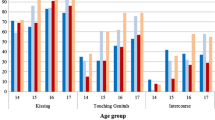Abstract
We examined the development of intimate relationships in 180 adolescents with visual impairment (VI) and 533 sighted peers. Adolescents with VI reported a later age at the time of first falling in love, dating, and entering into a romantic relationship. However, between-group differences in the timing of first sexual intercourse were not significant. In addition, similar numbers of adolescents from both groups had experiences with falling in love and having romantic relations at the time of assessment. The two groups differed in the criteria for mate selection, and emotional maturity was more important for young people with VI than for their sighted peers while the reverse was found for physical attractiveness and material resources of potential partners. Finally, the two groups did not differ in the perceived quality of their present romantic relationship.
Similar content being viewed by others
References
Moore, S., Rosenthal, D.: Sexuality in Adolescence: Current Trends. Routledge, Hove (2006)
Huurre, M., Aro, H.M.: Psychosocial development among adolescents with visual impairment. Eur. Child Adolesc. Psychiatry 7, 73–78 (1998)
Hicks, S.: Relationship and sexual problems of the visually handicapped. Sex. Disabil. 3, 165–176 (1980)
Gordon, P.A., Tschopp, M.K., Feldman, D.: Addressing issues of sexuality with adolescents with disabilities. Child Adolesc. Social Work J. 21, 513–527 (2004)
Kef, S., Bos, H.: Is love blind? Sexual behavior and psychosocial adjustment of adolescents with blindness. Sex. Disabil. 24, 80–100 (2006)
Pinquart, M., Pfeiffer, J.P.: Psychological well-being in visually impaired and unimpaired individuals: a meta-analysis. Br. J. Vis. Impair. 29, 27–45 (2011)
Bezerra, C.P., Pagliuca, L.M.F.: The experience of sexuality by visually impaired adolescents. Rev. Esc. Enferm. USP 44, 577–582 (2010)
Kef, S., Tielen, L.: Dating, romantic relations and sexual experiences of young persons with visual impairments. http://www3.psy.vu.nl/…/poster%20Vision%2008%20Kef%20&Tielen.pdf. Accessed 27 July 2011
Glass, D.G.: Sexuality and visual impairment. SIECUS Rep. 8(5), 1–4 (1984)
Brunnberg, E., Boström, M.L., Berglund, E.M.: Sexuality of 15/16-year-old girls and boys with and without modest disabilities. Sex. Disabil. 27, 139–153 (2009)
Hickman, S.E., Muehlenhard, C.L.: How young women and men communicate sexual consent in heterosexual situations. J. Sex Res. 36, 258–272 (1999)
Buss, D.M.: Sex differences in human mate preferences: evolutionary hypotheses tested in 37 cultures. Behav. Brain Sci. 12, 1–49 (1989)
Hasenkamp, A., Kümmerling, A., Hassebrauck, M.: Blinder Mann sucht schöne Frau? Evolutionspsychologische und soziokulturelle Erklärungsansätze der Partnerwahl [Are blind men looking for beautiful women? Evolutionary psychology and sociocultural explanations for mate-choice decisions]. Z. Sozialpsych. 36, 77–89 (2005)
Luszyk, D.: Geschlechtsunterschiede in Partnerwahlpräferenzen [Gender differences in mate preferences]. Z. Sozialpsych. 32, 95–106 (2001)
Vitz, P.C.: The Course of True Love: Marriage in High-School Textbooks. Institute for American Values, New York (1998)
Strawbridge, W.J., Wallhagen, M.I., Shema, S.J.: Impact of spouse vision impairment on partner health and well-being: a longitudinal analysis of couples. J. Gerontol. Soc. Sci. 62, S315–S322 (2007)
Byrne, J., Fears, T.R., Whitney, C., Parry, D.M.: Survival after retinoblastoma: long term consequences and family history of cancer. Med. Pediatr. Oncol. 24, 160–165 (1995)
Pfeiffer, J.P., Pinquart, M.: Attainment of developmental tasks by adolescents with and without visual impairment. J. Vis. Impair. Blind. 105, 33–44 (2011)
World Health Organization: International Classification of Diseases and Related Health Problems 10th Revision. World Health Organization, Geneva (2010)
Hill, R.: Campus values in mate selection. J. Home Econ. 37, 554–558 (1945)
Hendrick, S.S.: A generic measure of relationship satisfaction. J. Marriage Fam. 50, 93–98 (1988)
Sander, J., Böcker, S.: Die deutsche Form der Relationship Assessment Scale [German version of the relationship assessment scale]. Diagnostica 39, 55–62 (1993)
Cox, D.: Regression models and life tables. J. R. Stat. Soc. 34, 187–220 (1972)
Aiken, L.S., West, S.G.: Multiple Regression: Testing and Interpreting Interactions. Sage, Newbury Park (1991)
Engels, R.C., Knibbe, R.A.: Alcohol use and intimate relationships in adolescence: when love comes to town. Addict. Behav. 25, 435–439 (2000)
Crandell, J.M., Streeter, L.: The social adjustment of blind students in different educational settings. Educ. Vis. Handicap. 9(1), 1–7 (1977)
Lewis, V.: Development and Disability, 2nd edn. Blackwell, Malden (2003)
Acknowledgment
The present study was supported by a grant of the German Research Council (grant Pi291/9-1).
Author information
Authors and Affiliations
Corresponding author
Rights and permissions
About this article
Cite this article
Pinquart, M., Pfeiffer, J.P. What is Essential is Invisible to the Eye: Intimate Relationships of Adolescents with Visual Impairment. Sex Disabil 30, 139–147 (2012). https://doi.org/10.1007/s11195-011-9248-y
Published:
Issue Date:
DOI: https://doi.org/10.1007/s11195-011-9248-y



